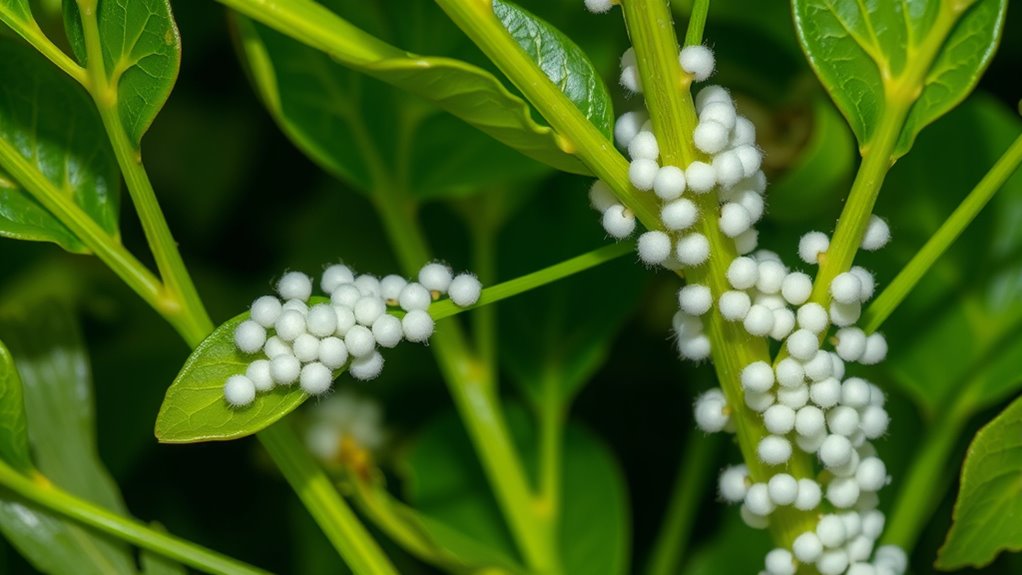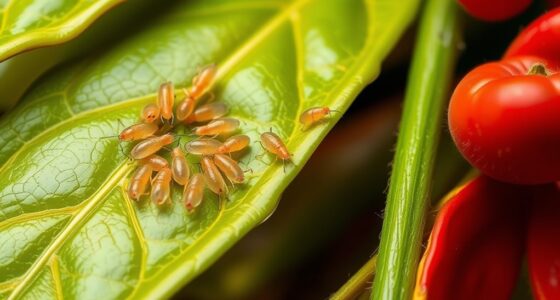If you spot fuzzy white or grayish cottony clusters on your leaves and stems, you likely have mealybugs. They feed on plant sap, causing leaves to yellow, stunt growth, and weaken your plant over time. These pests hide in leaf joints, under stems, and tight spots, making them hard to see. Using natural predators like ladybugs or applying organic treatments can help. Keep watching to discover more effective ways to manage this common pest.
Key Takeaways
- Mealybugs appear as fuzzy white or gray patches forming cottony clusters on leaves and stems.
- These pests feed on plant sap, weakening plants and causing yellowing and stunted growth.
- Early detection involves inspecting hidden spots like leaf joints and under stems for cottony infestations.
- Biological controls such as ladybugs and parasitic wasps effectively manage mealybug populations naturally.
- Regular cultural practices like manual removal and organic sprays help prevent and control cottony mealybug clusters.

Mealybugs often appear on the leaves and stems of plants, feeding on sap and causing damage. These cottony clusters can quickly weaken your plant if left unchecked. When you notice fuzzy white or grayish patches, it’s a sign that mealybugs have taken hold. They tend to gather in hidden spots—around leaf joints, under stems, and in crevices—making them tricky to spot at first. Early detection is key because the more you delay, the more they can reproduce and spread, leading to stunted growth, yellowing leaves, and even plant death if untreated. Integrated pest management strategies emphasize the importance of combining biological controls with cultural practices for effective eradication. One of the most effective ways to control mealybugs without resorting to harsh chemicals is to leverage natural predators. Ladybugs, for example, are voracious consumers of mealybugs and can markedly reduce their numbers. You can buy ladybug larvae and release them directly onto your infected plants. They’ll hunt down and eat the pests, helping restore balance naturally. Similarly, parasitic wasps, like Anagyrus pseudococci, are tiny but powerful allies. These wasps lay their eggs inside mealybugs, and when the larvae hatch, they consume the pests from within, effectively controlling the infestation. Introducing these natural predators creates an organic control method that’s safe for your plants, pets, and the environment.
In addition to biological controls, practicing good cultural habits can help prevent future outbreaks. Regularly inspecting your plants, especially in early spring and late summer, allows you to catch mealybugs early. If you find them, gently removing infested leaves or stems can make a difference. You can also use a cotton swab dipped in alcohol to dab directly on the pests, quickly killing them and disrupting their colonies. Applying insecticidal soap or neem oil can also be part of your organic control arsenal. These solutions suffocate or repel mealybugs without harmful residues, making them safe choices for organic gardening.
Frequently Asked Questions
How Do Mealybugs Spread Between Plants?
You can spread mealybugs between plants through pest transmission, often by sharing tools, pots, or even touching infected plants and then healthy ones. To prevent this, always perform plant quarantine when introducing new plants and thoroughly inspect them for pests. Avoid transferring mealybugs accidentally by cleaning tools and maintaining good garden hygiene, which helps contain infestations and reduces the risk of spreading these cottony clusters to your other plants.
Are Mealybugs Harmful to Humans or Pets?
Mealybugs aren’t harmful to humans or pets directly, but their toxins can cause skin irritation or allergic reactions if you handle infested plants frequently. You might face human exposure to these toxins through contact with contaminated plants or surfaces. While they don’t bite or spread disease, it’s best to wash your hands afterward and keep pets away from affected plants to avoid any potential irritation or allergic responses.
Can Natural Predators Completely Eliminate Mealybugs?
Natural predators can help reduce mealybug populations through biological control, but they often can’t completely eliminate the pests on their own. You should see biological control as part of an integrated pest eradication plan, combining natural predators with other methods like manual removal and insecticidal treatments. Relying solely on predators may not fully eradicate mealybugs, so it’s best to use a combination of strategies for effective control.
What Are the Signs of Early Mealybug Infestation?
Like spotting the first whispers of dawn, you notice subtle signs of early mealybug infestation. Conduct a careful visual inspection of your plants, especially around the undersides of leaves and along stems. Look for tiny, soft-bodied insects covered in a white, cottony residue. You may also see sticky residue or honeydew development, which indicates their presence. Catching these signs early helps prevent a full-blown outbreak and keeps your plants healthy.
How Long Does It Take to Control a Mealybug Outbreak?
Controlling a mealybug outbreak usually takes a few weeks, depending on infestation severity and control methods. You should implement biological control, like introducing natural predators, and adopt preventative measures such as regular inspections and maintaining plant health. Consistent application of insecticidal soaps or neem oil can help speed up recovery. Staying vigilant and acting promptly are key to minimizing damage and effectively managing the infestation.
Conclusion
In battling bothersome mealybugs, your vigilance and swift action prove essential. By regularly inspecting, removing, and treating affected areas, you prevent pesky populations from proliferating further. Remember, persistent prevention and prompt pest management protect your plants’ health and happiness. Stay steadfast, stay vigilant, and stop the spread of stubborn, seeping, and sneaky mealybugs to safeguard your garden’s glorious growth. Your dedication makes all the difference in defeating these tiny troublemakers.









